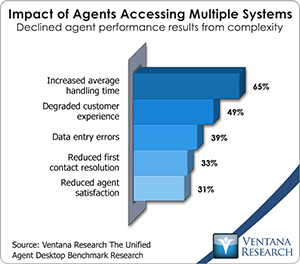My research and experience show that contact center agents and others handling customer interactions face the continuing challenge of meeting customer expectations while keeping down
My research and experience show that contact center agents and others handling customer interactions face the continuing challenge of meeting customer expectations while keeping down
Upstream Works provides smart desktop systems that can help companies overcome these issues. Its foundation product, UpStart Contact Center Agent, enables users to handle customer phone calls, email and chat sessions using the same workflow. It can be integrated with business applications to automate access to information required to resolve interactions and provides automatic updates across applications; for example, a new address is automatically populated in all relevant applications. UpStart can display previous interactions to help agents answer questions and requests in the context of the overall customer relationship. With its chat capability agents and supervisors can collaborate on resolving customer issues.
As part of its close partnership with Cisco Systems, Upstream Works has produced two desktop products that run within the Cisco Finesse desktop: Upstream Works for Finesse Omnichannel and Upstream Works for Finesse Voice. Cisco Finesse provides core call and agent state control (such as whether someone is available or busy) capabilities, while the Upstream Works products add capabilities of UpStart Contact Center Agent to help users handle customer interactions. The Omnichannel version enables users to handle multiple channels of engagement, whereas the Voice version is purely for handling phone calls; otherwise they have the same capabilities. The latest versions of the products support more sophisticated interaction routing, which is underpinned by enhanced skills management that makes it easier to add or change agent skills, assign agent locations and assign priority levels to skills. This allows companies to build routing rules that are based on agent skills, time of day, SLA targets and priority of tasks and to route interactions to the last person who engaged with that customer. Agents can view all tasks in their queue, which can be organized by priority and/or channel, and all completed tasks. Supervisors also can view these queues and if necessary take over tasks from the current agent or route it to another. Together these features help managers optimize interaction handling against selected targets and ensure that agents provide omnichannel customer experiences.
Upstream Works’ other product is Business Interaction Manager, which has performance management and analytics that enable companies to understand all aspects of customer relationships, especially their use of communication channels. It captures data from a variety of data sources, including transactional business applications such as CRM and ERP, and assisted (telephone) and self-service (IVR) engagement channels in real time. It stores the data in Interaction Hubs, which include two key features. One enhances interaction data with data collected from business applications, such as the customer’s name, status and reason code for the interaction. This allows the data to be analyzed in a multitude of dimensions such as location, user handling the interaction, type and outcome and gives users the information in formats they prefer. The second feature is the ability to tie together identifiers so that interactions can be grouped by customer; for example, telephone number, mobile number, email address, name, zip code and Twitter handle all can be associated to a single customer. This can be done manually at first, but over time the system can learn that interactions with a common identifier all belong to an existing customer. Such a capability is crucial as it allows the system to produce real-time customer journey maps that show what channels a customer uses and how he or she crosses channels to resolve an issue. In addition these maps can be updated if a customer starts to use a new channel that uses a different identifier. Outputs from Business Interaction Manager can be viewed in a variety of forms to suit different users and to help guide actions via the desktop systems.
Managing customer relationships in a multichannel world is not easy. Our benchmark research into next-generation customer engagement finds that companies plan to invest in diverse applications to help improve customer engagement; the top three are business process management (22%),
